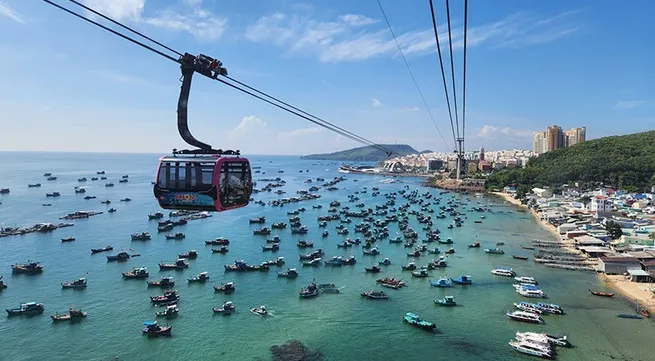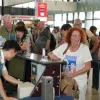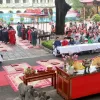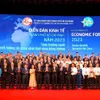Vietnam’s southwestern region bolsters domestic tourism demand

With rich natural resources, many localities have developed new and high-quality tourism products to enhance the experience of visitors. However, much remains to be done to tap into the existing potentials and advantages more effectively.
Diversified tourism products
In recent days, Nguyen Ba Vu’s vineyard on the island of Phu Quoc (Kien Giang Province) has welcomed hundreds of visitors who pose for photos with the ripe grapes. He also sells the fruit at prices ranging from 50,000-100,000 VND a bunch, depending on their size.
With a passion for agriculture and the wish to create an ecological attraction, Vu has experimented with growing Thai jackfruit, guava, jujube, and grape on his one-hectare plot of land.
Like Vu, many attractions in Phu Quoc have also constantly renovated and created many new products to attract visitors.
According to the Kien Giang Department of Tourism, the province welcomed 5.4 million visitors in the first half of 2024, with tourism revenue estimated at nearly 13.4 trillion VND (528 million USD), up 27.7% from a year ago.
Endowed with many natural scenic spots, Kien Giang is boosting tourism in a sustainable way, making it a key economic sector. Bui Quoc Thai, Director of the Kien Giang Tourism Department, said the province has increased cooperation with regional provinces to create a series of tourism products bearing the distinctive characteristics of each locality.
In An Giang, cultural-spiritual tourism has become a trademark with famous sites such as the Sam Mountain National Tourism Area, home to Ba Chua Xu Temple — the largest spiritual tourism complex in the Mekong Delta, which welcomes more than 4 million pilgrims each year.
In the first six months of 2024, An Giang welcomed over a million visitors, up 16% over the same period last year. Tourism revenue was estimated at 8 trillion VND (315 million USD), up 105%.
The province is working to create new tourism products to meet the demands and tastes of visitors, such as trekking and exploration in the Cam Mountain and tourism at the Chau Doc River junction combined with learning about the Cham culture in Chau Phong, said Le Trung Hieu, Director of the An Giang Trade and Investment Promotion Centre.
Despite being a latecomer, the tourism sector of Dong Thap Province has established its position in the Mekong Delta. In recent years, Dong Thap’s tourism sector has remained in the top four in the Mekong Delta in terms of visitor numbers. In 2023, the province welcomed over 4 million visitors and raked in 1.925 trillion VND (75.8 million USD). To achieve such initial success, Dong Thap Province has focused on developing ecological and agricultural tourism, combined with organising large events.
The Sa Dec Flowers and Ornamental Trees Festival held for the first time in 2023 attracted over 245,000 visitors, demonstrating the great appeal of a provincial event. In the past three years, Sa Dec has maintained the organisation of various festive events throughout the year.
According to Sa Dec Vice Chairwoman Vo Thi Binh, the festivals are held evenly around the year, not just around the New Year occasion. Another breakthrough implemented by Dong Thap to boost tourism demand is the biennial Lotus Festival, which bears the characteristics of the southwestern region.
A look at the number of visitors shows that tourism in the Mekong Delta holds great appeal. However, it should be noted that the region’s tourism growth has not lived up to its potential and there are certain limitations in tourism promotion activities.
Continuing to boost tourism demand
Like other provinces in the region surrounded by the Tien and Hau Rivers, Dong Thap possesses considerable potential for tourism development, especially in ecotourism, agricultural tourism and community tourism.
However, the province’s tourism offerings are not really distinctive, so the number of visitors, especially foreign ones, is rather small. Calls for investment into tourism remain limited, with no major investors pouring money into the sector.
Huynh Thi Hoai, Director of the Dong Thap Department of Culture, Sports and Tourism, said Dong Thap plans to focus on developing sustainable tourism on the foundation of green growth, aligning tourism development with agriculture, rural development and local cultural resources.
The province will form new intra-provincial and inter-provincial tourism routes and enhance the quality of the tourism value chain. At the same time, it will focus on developing traditional handicrafts and trade villages to enhance visitors’ experience.
According to Le Thi Hai Chau, Secretary-General of the Phu Quoc Tourism Investment and Development Association, the biggest difficulties facing Phu Quoc’s tourism sector are domestic flight routes and high air fares. In order for Phu Quoc tourism to take off, in addition to attracting international visitors, local travel agencies are taking various measures to boost domestic tourism demand, such as offering combos for air tickets and hotel bookings, removing surcharges, providing additional services and reducing entertainment costs. Phu Quoc continues to work with other regions to develop high-quality tourism routes.
In 2024 and subsequent years, An Giang will focus on implementing synchronous measures to promote effective and sustainable tourism development. Nguyen Trung Thanh, Deputy Director of the An Giang Department of Culture, Sports and Tourism, said the province’s tourism sector will continue working to upgrade tourism sites, local festivals, and tourism services as well as cooperating with other provinces and cities in Vietnam to attract more visitors.
The reality has shown that boosting domestic tourism demand requires southwestern provinces and cities to implement synchronous measures and the active participation of the business community and tourism service businesses. More importantly, in addition to potentials and advantages, localities need to clearly identify their shortcomings in tourism development.
Tags:





